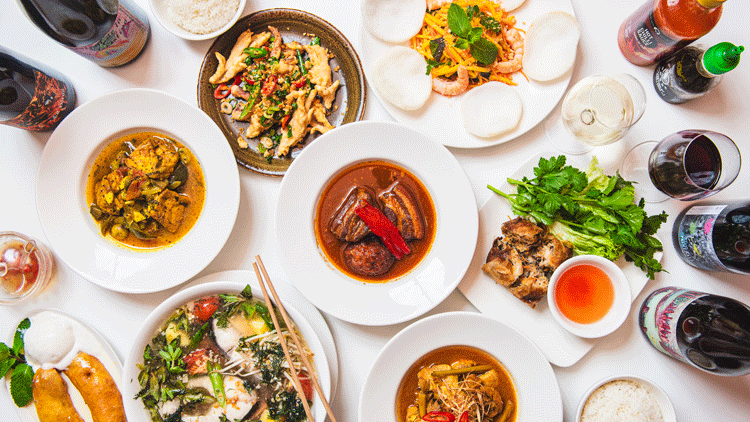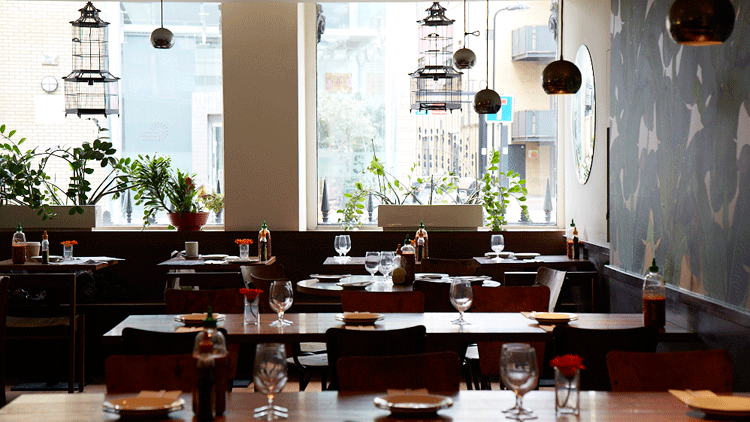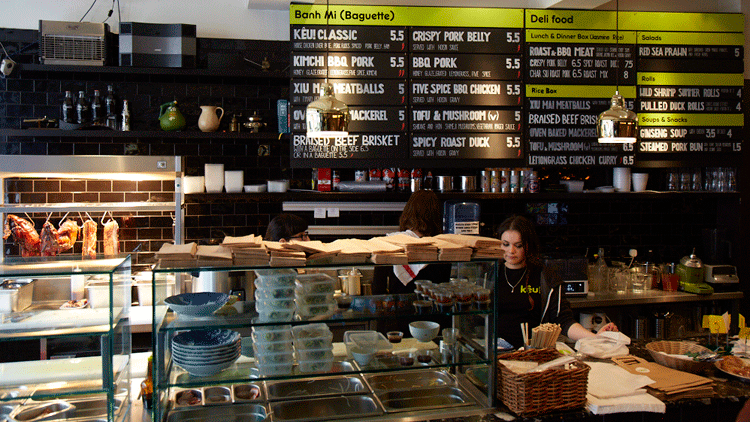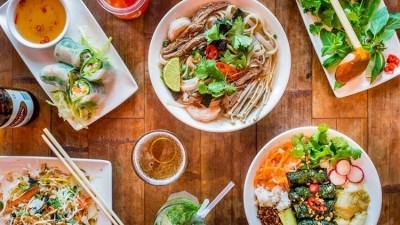Souper hero: How Hieu Bui conquered London’s Pho Mile
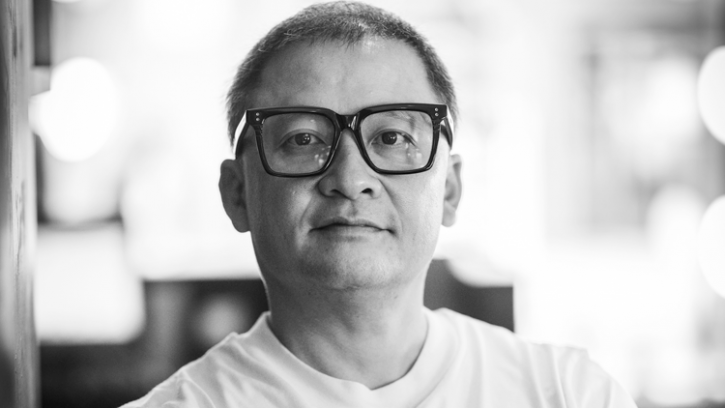
“Don’t smell it!” Hieu Bui is taking us through the finer points of eating chả cá lã vọng, a Vietnamese dish of turmeric-marinated fried catfish that is finished at the table with a portable gas burner and an enormous pile of dill fronds.
The orange-hued fish is served with a salad of shredded spring onion and chilli, rice noodles, peanuts and a bowl of sauce that is largely made up of fermented shrimp. It is the latter that Bui is advising us not to get too close to.
“Sometimes people smell it and then don’t like the dish,” he grins. Even from a distance, it smells offputtingly shrimpy. But when administered sparingly, it provides the hit of umami that pulls the whole dish together.
Located on East London’s famed Pho Mile at the beginning of the stretch on Old Street, Bui’s Cay Tre restaurant offers many of the same Vietnamese staples as its neighbours but also has a significant sideline in more adventurous dishes, of which the chả cá lã vọng is certainly one.
Cay Tre wasn’t the first Vietnamese restaurant on the Pho Mile – that honour goes to Viet Hoa, which is now located five minutes’ or so to the north on Kingsland Road - but it is one of the area’s most successful places to eat.
It’s also one of only a handful of Vietnamese-owned businesses on the stretch to have expanded across the capital. Since establishing the restaurant 20 years ago Bui has opened a Cay Tre in Soho and a trio of restaurants under his faster-paced spin-off brand Keu.
Born in Vietnam
Bui was born in Hanoi but is familiar with the food of the south of the country too having also lived in Saigon. From a gastronomic standpoint this has proved useful, he says. “The two cuisines are very different. A lot of people don’t know the difference between them, even Vietnamese people.”
Northern cuisine is often regarded as more refined than that of the south and uses fewer chillies, herbs and spices (partly because the climate is colder). By contrast, southern cuisine tends to be sweeter and more aromatic and often features coconut milk.
Bui is from a relatively affluent background and was sent to London in 1999 by his mother to study for a degree in marketing. Soon after arriving, he took a job as a waiter at Viet Ho on Kingsland Road. Straight away, he realised that the food being served was far removed from that served back home.
“The way the food was cooked, and the quality was very different to what I was used to. I knew 100% that I could do it better,” says Bui, who went on to work at a number of other restaurants on the Pho Mile including Hung Viet.
The plan was to return to Vietnam after completing his degree, but while waiting for a bus on Old Street he spotted the vacant site that is now Cay Tre. Using a mix of his own funds and backing from his family back home he launched the restaurant with help from his uncle.
“He was not a chef, but he loved food and had a good understanding of how Vietnamese dishes should be prepared,” says Bui, who worked front of house at the restaurant in the early days but also had a lot of input into the menu. “I was only going to do it for a couple of years, but it was a big success. So, I have stayed.”
Doing things properly
The pair’s approach was hardly ground-breaking; they simply prepared dishes according to authentic recipes and refused to cut corners, revelling in the more laborious aspects of the cuisine and less obvious dishes.
“Take the pho for example,” he explains. “When I was working for another of the restaurants on Kingsland Road we ran out of the broth. An hour later, pho was back on the menu. That is not possible if you are doing things properly.
At his restaurants, marrow bones are soaked to remove the impurities and are then simmered for 24 hours. The kitchens also make all their braised meats fresh, rather than make them up in batches and freeze them as other restaurants have been known to do, and all of its pancakes are made to order.
Another thing that made the restaurant stand out from the crowd was a focus on sourcing higher quality meat than the competition and offering a great selection of wines compiled by wine writer Malcom Gluck, who remains a consultant for the group.
While the food menu at Cay Tre was largely in line with what was available elsewhere on the stretch, both Vietnamese and western customers soon started to notice the difference in quality and the restaurant became extremely busy despite its necessarily marginally higher price point.
Cay Tre’s success soon saw Bui launch a second Vietnamese restaurant about five minutes to the north on Kingsland Road. Launched in 2006, Viet Grill serves many of the same dishes as its older sibling but also offers a handful of more elaborate menu items.
The restaurant has Mark Hix to thank for its name. The chef was a regular at Cay Tre and struck up a friendship with Bui. “He said my food was good but that the restaurant’s name was too difficult to remember. He had Rivington Grill at the time (which was just across the road) so I took inspiration from that.”
Heading west
Fast forward five years to 2011 and Bui expanded again, this time bringing Cay Tre to Soho. Sited on Dean Street, the 100-cover restaurant was a ballsy move that cost around £1m to get off the ground, but it was one that ultimately paid big dividends.
“There were only one or two Vietnamese restaurants in the West End, and they were small and basic,” he recalls. “At the time, if you wanted to eat real Vietnamese food in London you had to come to Shoreditch.”
Now the group’s largest and busiest site, Cay Tre Soho proved that a cuisine that was largely ghettoised in London could compete in a mainstream location. On top of this, Bui brought people in to create a strikingly modern restaurants design that avoided many of the cliches of Asian restaurant design. “We wanted to move away from a canteen-like street food feel. We were the first Vietnamese restaurant in London to invest in a proper architect and interior designer.”
A year later and the restless restaurateur was at it again, this time addressing what he saw as multiple gaps in the market with a new concept called Keu. Challenging the notion that Vietnamese food had to be served in a full-service environment, Keu launched with three main food pillars: banh mi (the Saigon submarine-style sandwich), pho, and roast meats (and a few other things) served over rice. Prices are accessible, with large dishes ranging between £9 and £14.
“Nowhere in London sold banh mi. I also noticed that there was nowhere in Shoreditch that served Chinese-style roast meats, which are popular all over Vietnam,” says Bui, who spent the best part of a year working with baker Sally Clarke to develop the perfect banh mi baguette.
Since then, two more sites have followed, one on Soho’s Poland Street and another in The City near London Wall.
Weathering change
Like nearly all operators, the restaurateur is finding the current trading environment tough. Things are easier in Soho than they are out east, he says. “Shoreditch has changed. It’s much quieter in the evenings now, especially since the pandemic. A lot of our trade was drawn from drinkers on Hoxton Square. Not so long ago, they had to have police there to control the crowds spilling out from bars, but the area is dead now.”
“We are busy enough, but the crowd has changed. It used to be all hipsters and arty people, but they all moved out when house prices went up. We now get a lot of people from The City and Essex coming to eat here.”
Next year, he will reassert his credentials as a Vietnamese restaurateur determined to do things differently by overhauling Viet Grill’s interiors and offer (it may even change its name). With competition in the area more intense than ever, the restaurant will further differentiate itself by introducing a tighter menu that brings grilled dishes to the fore.
Inspired by Western-owned new wave Thai restaurants including Som Saa and Smoking Goat, the restaurant will offer a mix of small and large plates and use even better quality meat. New grilled dishes will include a Vietnamese-style duck ‘kebab’, grilled Tamworth pork chops, large cuts of beef and lamb to share and various grilled seafood items.
Beyond that, the focus is most likely to be on further expanding the Keu brand, his most successful endeavour to date, it seems, and also the easiest to roll out, requiring smaller locations and fewer staff. More Keus are set to launch in the coming years as well as the possibility of a full-service restaurant in west London, an area that has relatively few Vietnamese restaurants.
It’s a speed of growth that he acknowledges does not match the likes of Western-owned brands that also occupy the Vietnamese space, including the 40-strong Pho, which has private equity backing from TriSpan, and HOP Vietnamese, but is one he is nevertheless happy with.
“What we are doing is different,” he says with a knowing look. “We are offering the real thing.”
